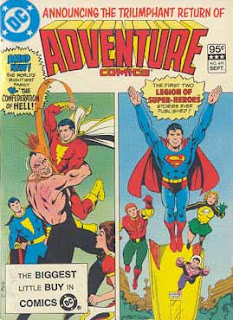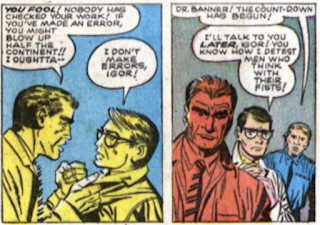Tuesday, June 6, 2023
Wednesday Comics: DC, September 1982 (week 2)
Monday, June 5, 2023
The Plane of Whatever It is, I'm Against It
No one is quite certain how the Concordant Opposition came to be. It is quite possible that some soldiers of Law and some warriors of Chaos tired of the endless battle of natures and paradigms and came together in that consensus to make another alternative. Others believe (or hope) that it is the place where the last fragment of the Godhead exists. a strange loop of dreaming God unconsciousness, a bulwark against a schizoid multiverse. People in the City of the Sigil, in particular, like this idea.
However it came to be, it stays because he serves a purpose. It's the phase boundary between not only Law and Chaos but the other syxygies which emerged from their conflict come together. It is the place of concordant. Of course, it actively resists being incorporated into any camp (though they all try). It is a place of opposition.
Across it's expanse none the Powers hold sway, yet no where are their philosophies more discussed and debated. There are groups of evangelists and missionaries from other Planes working to convert travelers, though these all die out eventually, either in conflict or by loss of faith. The plane does not mock, but it is actively indifferent.
At the edge of these Outlands are the Border Towns. Their appearance vary from town to town, but they control the flow of traffic from whatever plane is on the other side. All are fortified, no matter how benign the appearance of the Plane on the other side. Indeed, from the perspective of the Opposition, the most benign are often the most dangerous.
Friday, June 2, 2023
Swords Against Sorcery: Kharron the Slayer! Anatomy of a Pregen
Kharron was one of the pregens I put together for the first playtest of my in-progress comic book Swords & Sorcery ruleset, Swords Against Sorcery. I don't know any more about Kharron and his background than these stats suggest. I gave the player a picture of DC's Stalker as drawn by Steve Ditko for an illustration, but I also had in mind Kharon: Scourge of Atlantis, a character created by my friend Jim Shelley and artist Pierre Villeneuve for the Zuda competition. Jason Sholtis drew this rendition with that in mind:
Anyway, every SAS character has two Archetype descriptors. These determine what abilities they have. For Kharron these are Cursed Warrior.
His Distinction is "Neither Living Nor Dead," which can come into play as a special bonus once per session, but can also be used as a penalty at other times.
These are the primary abilities of the game. Every roll is a Attribute plus a Domain with situational modifiers. I talked about these before. Attributes range from 1-5 (with 2 being the minimum for heroes) and Domains 0-4 (with 1 being the minimum for heroes).
Expertises and Talents further flesh out a character. Expertises are skills they are exceptionally good at, while Talents are sort of special abilities that allow a character to "break" the usual rules n certain circumstances.
Wednesday, May 31, 2023
Wednesday Comics: DC, September 1982 (week 1)
Monday, May 29, 2023
Swords Against Sorcery: Wizard's Challenge!
Last night, I did the first playtest of the Bronze Age comic book Swords & Sorcery system I have been working on. I made a few pregens and this was the line up:
- Oriax the Red, Gladiator Champion (Aaron)
- Thunda, Barbarian Acolyte (Andrea)
- Korag, Primitive Warrior (Jason)
- Kharron, Cursed Warrior (Paul)
Meanwhile, Kharron as emerged from the water with the jewel which feels strangely warm in his hand, but then, the statue comes to life with a grinding of it's stone joints. Thunda calls upon her gods and the demon is transfixed for a moment, buying them a little extra time.
Thursday, May 25, 2023
Dr. Banner or: How I Learned to Stop Worrying and Love the Gamma Bomb
The first mystery (this one obscured by governmental secrecy) is just what the gamma bomb was. It was not a gamma ray weapon—though that was exactly what Banner had dangled in front of the Army to get his project off the ground. Once he had funding and security clearance, Banner went for something more daring: he planned to build the K-Metal Bomb the German’s had sought near the close of World War II, but never perfected. He hoped to use the K-Metal (or Kryptonite as it was becoming popularly known) to power a weapon that would weaken and incapacitate but not kill (in a manner similar to so-called “slow kryptonite” developed years later by Metallo) and would also not destroy infrastructure. “Gamma” became the Army’s codename for this weapon.
Not only were the generals incredibly interested in what Banner was offering, but Banner’s secrecy (either conscious or unconscious) regarding the physics involved only served to leverage a virtual celebrity status for him. A status coupled with Cold War thinking regarding means and ends would prove disastrous for more than one person present that faithful day. Truth being more complicated than fiction, Windsor-Smith's version of these events in Monster would split Banner into two characters: a traumatized victim of a sadistic experiment and the sadistic scientist running the experiment.
Which brings us to the oddest figure in this drama, “Igor Starsky,” the Soviet spy. Igor had been assigned to establish a relationship with Banner in graduate school—something not easy to do with the young physicist. For reasons of his own, Banner suffered Starsky’s presence, but seldom showed him any genuine warmth. When they were working together on the gamma bomb, he often treated the man like a lackey. Samson surmises that Starsky’s presence on the project was merely another way for Banner to assert his mastery over Ross, his father surrogate. He was the personification of foreign power in Ross’ domain. Banner would deny ever having considered that Starsky might be a Soviet agent, but he pointedly did not reveal any more of the science involved with the project to his colleague than to the military.
Why did Starsky attempt to kill Banner in the gamma bomb test when his presumed mission was not yet completed? Clearly, he had reason to resent Banner for the treatment he had received, but wouldn’t have stealing Banner’s secrets for his government been revenge enough? Samson believes Starsky’s murderous feelings against Banner were a reaction-formation of his attraction to the scientist. His tolerance of abuse had been the masochistic, unconscious expression of the depth of his feeling, but in a pivotal moment he pushed the button to free himself from Banner, and perhaps the intensity of his own feelings, once and for all.
That isn’t, of course, how it turned out.








































